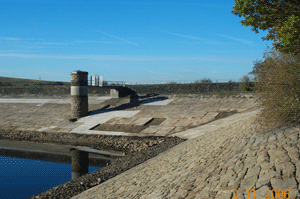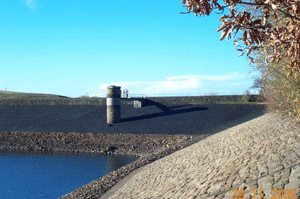Walkerwood Reservoir Safety Works
Introduction
Walkerwood Reservoir is the lowest reservoir of a series of four in a valley above Stalybridge in Cheshire. It is owned and operated by United Utilities and provides a supply of drinking water. The Reservoir is also used for fishing and the surrounding area is a popular amenity area for walkers.

The reservoir dates from the 19th Century and the dam consists of a clay core within an earth embankment. The embankment was originally protected from erosion with stone pitching which was overlaid with in-situ concrete slabs. The concrete slabs have been patched and repaired as they have deteriorated over the years.
After a regular inspection it was decided that the concrete slabs no longer gave sufficient protection against wave attack so the reservoir level was lowered to allow work to upgrade the revetment. Various options were considered including removal and replacement of the failed concrete panels, and an overlay with concrete blocks.
The Solution
The solution chosen was to fill the existing holes in the concrete with LEAN SAND ASPHALT (LSA) and overlay the whole area with OPEN STONE ASPHALT (OSA).
The main contractor for the works was May Gurney Limited.
This technique had the following advantages :
- No material had to be excavated and removed off site (costly and environmentally unacceptable)
- Preparation works were minimal only involving cleaning and priming concrete surfaces.
- Installation of LSA and OSA is very quick.
- The crest access road could be kept open to traffic during the works.
- The solution was better value for the client
- The technique has an excellent track record having been used on UK reservoirs since 1991.

- No material had to be excavated and removed off site (costly and environmentally unacceptable)
- Preparation works were minimal only involving cleaning and priming concrete surfaces.
- Installation of LSA and OSA is very quick.
- The crest access road could be kept open to traffic during the works.
- The solution was better value for the client
- The technique has an excellent track record having been used on UK reservoirs since 1991.
Materials
- Open Stone Asphalt
Open Stone Asphalt is a high void content gap-graded and underfilled mixture of aggregate, bound by a thick and durable film of mastic binder, which is a mix of sand, limestone filler and bitumen. The film is resistant to weathering and ageing and fixes the open skeleton of stones to withstand mechanical loads from waves and flow.
Typical stone sizes used for OSA are 20/40mm and 20/32mm but finer gradings may be used for special applications, e.g. footways. The type of aggregate is chosen carefully as the adhesion between the aggregate and bitumen is very important for the material’s long-term durability. Usually limestone is preferred over harder aggregate.
The quantity of mastic for a complete coating of the aggregate is dependent on the size, shape and surface properties of the aggregate, and the mastic’s viscosity. The viscosity of the mastic at mixing and placing temperatures is very important – too low and it will sag through the mix (segregate) and seal the filter layer below – too high and the coating of the stones may not be complete.
The void content of the placed material varies between 20 – 25%.
In general OSA comprises of :
- Stone 18 – 22% by mass
- Mastic 78 – 82% by mass
The mastic comprises of :
- Sand 55 – 66%
- Limestone Filler 16 – 25%
- Bitumen (100-150 pen) 17 – 21%
It should be noted that the above ranges cover a wide variation in the actual raw materials available at any particular location – they are not mixing tolerances.
For each project suitable mixing plants are selected and the raw materials available are analysed. The results of the tests will determine if the materials are suitable, and if so, the actual mix design for those materials.
- Lean Sand Asphalt
Lean Sand Asphalt (LSA) is a mixture of sand (96%) and bitumen (4%). The sand grading is not critical so the most readily available sand is usually used. The resulting uncompacted material has a void content of approximately 40%.
Summary
- Total area protected was over 5,000 m2
- 1250 tonnes OSA used
- Works took 4 weeks including preparation works




